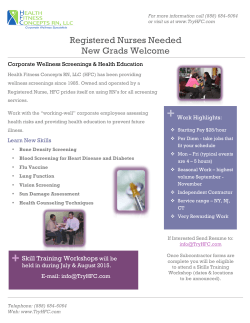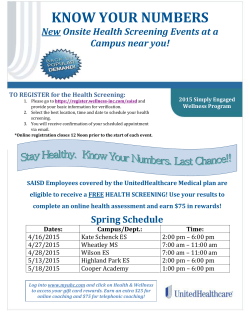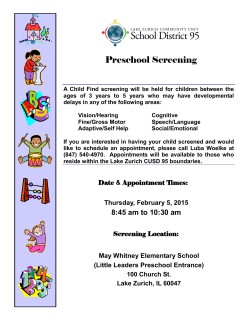
Building Skills in Health Promotion and Chronic Disease Prevention
Building skills in health promotion and chronic disease prevention for the DNP prepared nurse practitioner: A multigenerational case-based approach Gail Johnson, DNP, APRN; Basia Belza, PhD, RN, FAAN; Christine Hoyle, DNP, APRN University of Washington DNP Role in Health Promotion—Disease Prevention Essential Skills • Analyze epidemiological, biostatistical, environmental data • Apply evidence-based approaches to individual and population health • Risk assessment • Risk reduction • Screening The Challenge • To teach DNP students new skills that they can apply in a practical way to real life situations • To develop a creative approach to teaching in a large class of 90 students • To keep interaction meaningful among students in a 50% online, 50% in person course Multigenerational Family Case Components • Family case includes 4 generations • Illustrates individual risk factors, family connections, community dynamics • Multiethnic • Health profile developed for each family member Charles Charles is a 79 yo male, retired, former maintenance worker, married to Betty for 56 years. 2 children; one died accidental death age 22. Son Rob lives in same city. 3 grandchildren and 2 great grandchildren. Charles has wellcontrolled HTN and DM type 2. Charles’ Health Profile Diet: Wife cooks. Tries to eat a low fat, low cholesterol diet, likes fruits but doesn’t eat a lot of vegetables, coffee 2 cups a day. Struggles with his weight. Elimination: No concerns Sleep: Sleeps 8-9 hours a night Habits: Former smoker, drinks occ. beer, exercises with evening walk with dog around the block. Meds: Lisinopril 20 mg a day, Metformin 1000 mg twice daily Allergies: NKDA Patient Profile: Lives with wife in their own home, 3 grandchildren, 2 great grandchildren. Supports include wife and son. ROS: HTN past 5 years, well controlled on medication, DM type 2, dx’d 4 years ago, initially diet controlled, on metformin past 2 years. Family Hx: • Mother: HTN, died age 85 from stroke • Father: unknown Luis • Luis is a 3 year-old mixed Caucasian/ Hispanic male, daughter of Chris and Maria. Luis lives with his parents and sister. His father works in construction. His mother stays home. Luis was last seen 2 months ago in the emergency room for stitches when he cut his forehead in a fall from the porch. He has a history of asthma and eczema, well controlled currently. Luis’ Health Profile Diet: Eats all table food, especially likes tortillas, cheese, fruits, not vegetables. Drinks whole milk - 8 ounces with each meal. Drinks soda on weekends, some candy, no gum. Elimination: Recently completed toilet training for bowel, dry during day and most nights; night wetting about once a week. Mom not concerned. Sleep: Sleeps through night. Naps most days for an hour in afternoon. Safety: Mom has Ipecac and gate for stairs, no cupboard locks or outlet protectors. Mom states Luis is very active and she can't be watching him every minute due to infant; states he "has to learn things the hard way." Development: Dresses and feeds self. Can follow simple directions and likes to be a "helper". Parents have no concerns, but wonder about his speech. Describe him as an active, happy, loving little boy. Language- Mom states he babbles and sometimes says words that she can understand like "milk", "potty", "go", and "baby". Can follow her directions and she thinks he understands and hears well. Often points to what he wants. Spanish and English are used in the home. Patient Profile: Family lives in Seatac, low to middle class neighborhood, renting home; many children in neighborhood. Luis plays well with others most of the time. Cared for by Mom at home. Watches TV 3-4 hours every day. Immunizations: Hep B x 3, DtaP x 2, IPV x 2, Hib x 2, MMR at 12 mos. Family Hx: mother--asthma, allergic rhinitis, grandfather--HTN Assignment #1 Risk Assessment • Choose a Family Member • Identify health risks based on population data for age group • Identify additional risks based on PMH, personal habits, FH • Identify health promotion goals • What is a strategy for risk assessment to use in Primary Care setting? Pros and Cons? Assignment #2 Risk Reduction • Revisit your patient from Assignment #1 • Identify a risk reduction strategy for this patient to be used in a Primary Care setting • Review evidence behind this strategy. • What are the shortcomings to this approach? • What are the recommended vaccines for this patient? Assignment #3 Screening • Choose a screening guideline to review – Sensitivity, specificity, predictive value? – Characteristics of disease, test and population screened? – Sources of bias in screening? – Differences in guidelines for this test? • Recommend evidence based screening guidelines for a chosen family member Assignment #4—Population Health • Explore the health indicators of the community of SeaTac in which fictional family lives • Choose one indicator related to one family member and explore in depth • Plan a health promotion approach to address this indicator from a community perspective – Frame with a Health Promotion Theory – Consider strategies for risk assessment, reduction, screening – Consider behavior change, health education/communication approach – Consider a specific population approach Evaluation • Graded participation in online case discussion • Peer and faculty feedback to online postings • Course evaluation Next Steps • Consider further integration of case in DNP core curriculum—e.g. Health Policy and Politics; Social Determinants of Health; Program Evaluation and Quality Improvement • Build on the case in second and third year clinical course assignments related to advanced health assessment, disease management and pharmacology Summary • Real world application of concepts of risk assessment, risk reduction and screening helps advanced practice nursing students develop the necessary skills for future practice. • The multigenerational case approach can easily be adapted to other cultures, communities and health professions.
© Copyright 2025










